Hagia Sophia › Food in the Roman World » Origins and History
Articles and Definitions › Contents
- Hagia Sophia › Ancient History
- Food in the Roman World › Antique Origins
Ancient civilizations › Historical places, and their characters
Hagia Sophia › Ancient History
Definition and Origins

Hagia Sophia in Istanbul, constructed 532-537 CE, continues to be revered as one of the most important structures in the world. Hagia Sophia ( Greek Ἁγία Σοφία, for 'Holy Wisdom') was designed to be the major basilica of the Byzantine Empireand held the record for the largest dome in the world until the Duomo was built in Florence in the 15th century CE. Additionally, Hagia Sophia became more important with time as subsequent architects became inspired by the dome when building later churches and mosques.
CONSTRUCTION & DESIGN
After the Nike Riots of 532 CE destroyed the previous basilica in Constantinople, Emperor Justinian sought to create the greatest basilica in the Roman Empire. He charged two architects, Anthemios of Tralles and Isidore of Miletus to create a structure worthy of the capital of the Roman Empire. The architects, who were primarily mathematicians, made use of new architectural concepts in order to build exactly what the emperor wanted. In order to create the largest interior space possible, they designed an enormous dome and supported it using a revolutionary construction method called pendentives. Hagia Sophia makes use of four triangular pendentives which allow for the weight of the circular dome to transition to a square supporting superstructure below without massive pillars or columns interrupting the internal space.
THE ENORMOUS DOME IS SUPPORTED USING A REVOLUTIONARY CONSTRUCTION METHOD.
The dimensions of the extant structure show Hagia Sophia's near square shape: length 269 feet (81 m), width 240 feet (73 m).The cupola of the current dome hovers 180 feet (55 m) above the mosaic floor. The structure and first dome, which partially collapsed in 557 CE, were first completed in 537 CE. The second dome, designed with structural ribs and a greater arc than the previous dome, was designed by the nephew of one of the original architects, Isidore the Younger.
Isidore the Younger was faced with fixing several issues that had caused the original dome to collapse. First, during the original construction, the bricklayers had heedlessly applied more mortar than brick. Additionally, in the rush to complete the original dome, they had not waited for a layer of mortar to set before applying the next level of bricks. This caused structural problems that were only exacerbated by a dome which was too shallow. When a dome's arc is round enough the weight and force of the structure descends down into the supporting piers. However, the original dome's arc was too shallow, thereby, pushing outward and forcing the already weakened walls to give. To fix these problems Isidore the Younger increased the height of the dome, which increased the arc and depth, and added 40 ribs to provide support. Before these improvements, however, he was forced to rebuild much of the original walls and semi-domes in order to make the new dome last longer than the first.
DESCRIPTONS OF THE DOME
This history of the two generations of architects and two separate domes are known through both Byzantine authors and through 20th century CE architectural surveys. The magnificence of Hagia Sophia is recorded throughout the centuries as shown in this description by a 9th century CE patriarch of Constantinople named Photios:
It is as if one were stepping into heaven itself with no one standing in the way at any point; one is illuminated and struck by the various beauties that shine forth like stars all around. Then everything else seems to be in ecstasy and the church itself seems to whirl around.
In the 20th century CE, many architectural engineers were fascinated by the scale of Hagia Sophia and wanted to know how it was designed, executed, and built. Robert Van Nice, working for Dumbarton Oaks, was the first Westerner given access to the newly secularized Hagia Sophia in the 1930s CE. Van Nice's structural analysis was subsequently published in the 1960s CE.
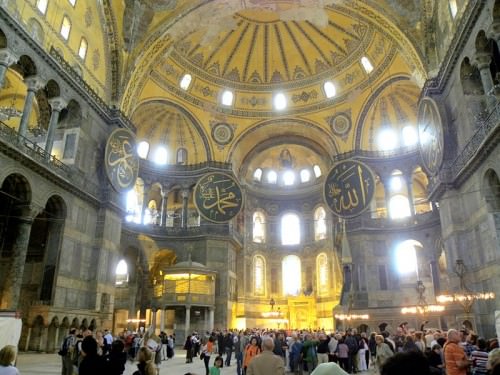
Hagia Sophia, Istanbul
The aesthetic qualities of a geometric design are what most concern the twentieth century work on Hagia Sophia. Due to the association of beauty, harmony, and mathematics, an objective description of Hagia Sophia reveals a certain beauty concerning its design. This is true of many structures built in Ancient Rome and Late Antique Constantinople, for example. As Anthony Cutler wrote in the 1950s CE, “the essential and manifest characteristic of early Byzantine architecture, the disciplinary relationship between mathematics and structural mechanics.” For example, the design of Hagia Sophia makes use of pendentives as an aesthetic choice that creates harmony and symmetry. According to Cutler, the pendentive is a geometric solution to an engineering problem that simultaneously creates an aesthetic affect. This interplay of geometry and beauty characterizes Byzantine understanding and engineering genius. The dome's design symbolizes something immense and beautiful.
INTERIOR DECORATION
The interior of Hagia Sophia was innovative in its decoration as well. The interior is lined with enormous marble slabs which may have been chosen and designed to imitate moving water. The central dome is floated on a ring of windows and supported by two semi-domes and two arched openings. This creates an enormous uninterrupted nave. The pendentives were covered with enormous mosaics of six winged angels called hexapterygon. The two arched openings are supported by massive porphyry columns which descend all the way to the floor. Originally the nave was lined with intricate Byzantine mosaics which portrayed scenes and people from the Gospels. After the Ottoman Conquest, many of these mosaics were covered over with Islamic calligraphy and only rediscovered in the 20th century CE after the secularization of Turkey (Hagia Sophia became a museum in 1935 CE). This includes the mosaic on the main dome which was probably a Christ Pantocrator (All-Powerful) which spanned the whole ceiling and is now covered by remarkable gold calligraphy. On the floor of the nave there is the Omphalion (navel of the earth), a large circular marble slab which is where the Roman and Byzantine Emperors were coronated. One of the final additions the Ottoman Sultans made to finalize the transition from Christian basilica to Islamic mosque was the inclusion of eight massive medallions hung on columns in the nave which have Arabic calligraphy inscribed upon them with the names of Allah, the Prophet, the first four Caliphs, and the Prophet's two grandsons. The Ottomans also added a mihrab, a minbar, and four enormous minarets in order to complete the transition to a mosque.
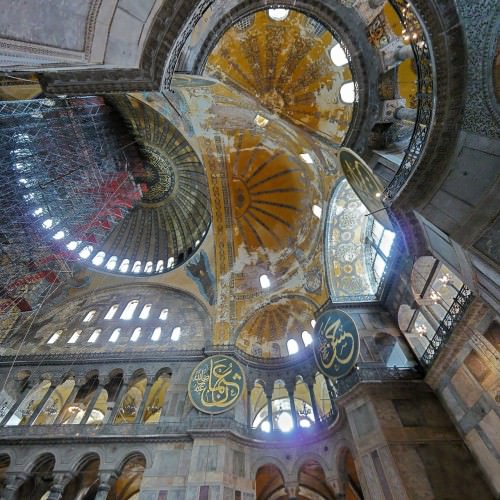
Hagia Sophia Interior
INFLUENCE ON LATER ARCHITECTS
The daring genius of the architects made use of pendentives and tympana on a scale not previously envisioned. Their use of innovative techniques include a brick aggregate that is lighter and more plastic than solid stone or concrete which allowed for the dome to create an internal space not surpassed in Western Europe for 1,000 years. Additionally, after the fall of Constantinople in 1453 CE, the genius of Hagia Sophia's architects continued to dominate the conquering Ottomans who made use of the designs for their mosques. The Ottomans conquered the city, but the artistic culture of the Byzantines, in a way, conquered the Ottomans. Hagia Sophia, under orders from Mehmed the Conqueror, was converted into a mosque within days of the conquest preserving the Byzantine architectural legacy in a new form and era.
The most famous Ottoman architect, Sinan, was directly influenced by Hagia Sophia and other Byzantine structures. Working in the time of Suleyman the Magnificent, Sinan designed numerous imperial mosques and other structures with the same hemispherical dome-supported pendentives upon parallel semi-domes and walls. A layout and design certainly inspired by Hagia Sophia. Hammond suggests Sinan's greatest work, the Suleymaniye Mosque completed in 1557 CE, maintains a continuity with Hagia Sophia while simultaneously synthesizing it with the then contemporary Renaissance architectural innovations occurring in Italy.
Later Ottoman mosques were equally influenced by Hagia Sophia. The Blue Mosque, for example, preserves a layout inspired by Hagia Sophia that builds upon its innovations of pendentives and semi-domes to create internal space. Additionally, Islam's use of geometric shapes and patterns, as opposed to Orthodox's use of icons, also finds continuity in Greco-Roman-Byzantine's use of geometry in sacred architecture as mentioned previously. In fact, the very same Sinan who built the Suleymaniye also worked to repair the millennium-old Hagia Sophia during the reign of Selim II.
In addition to the impact Hagia Sophia has had on Ottoman architecture, it also inspired and influenced Greek and Russian Orthodox architecture for centuries. Victoria Hammond, author of Visions of Heaven: The Dome in European Architecture, in particular, suggests that Russian Orthodox basilicas in Moscow and Kiev were directly inspired by early Muscovite contact with Constantinople in the 10th century CE.
Despite the finality of the transition from Byzantine to Ottoman with the removal of the Christian icons Hagia Sophia continued in its function as a sacred space as a mosque called Ayasofya. Even today Hagia Sophia maintains its position as a sacred space, despite its current position as a secular museum, because of what it inspires, what it symbolizes, and the effects it creates on visitors. The original architects' vision of a structure as the synthesis of religion and mathematics determines the impact it has on the viewer. And in return, it is the impact that Hagia Sophia has on the eye which determines its lasting importance and beauty. It's scale, symbolism, and transcendence of the construction material demonstrate what Justinian said when it was first completed in 537 CE, “O, Solomon, I have outdone thee!”
Food in the Roman World › Antique Origins
Ancient Civilizations
The ancient Mediterranean diet revolved around four staples, which, even today, continue to dominate restaurant menus and kitchen tables: cereals, vegetables, olive oil and wine. Seafood, cheese, eggs, meat and many types of fruit were also available to those who could afford it. The Romans were also adept at processing and conserving their food using techniques from pickling to storage in honey. Flavouring food with sauces, herbs and exotic spices was another important element of Roman food preparation. Our knowledge of just what the Romans ate and how has been gathered from texts, wall -paintings and mosaics, and even the remains of the food itself from sites such as Pompeii.
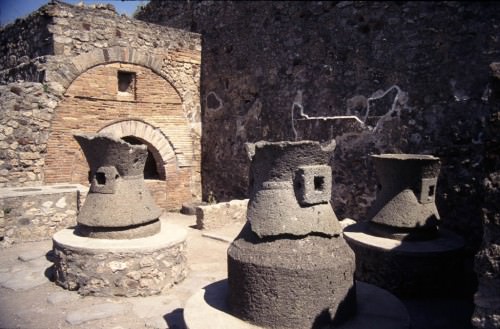
A Pompeii Bakery
CEREALS
Cereals made up the bulk of most people's diet with wheat and barley being the most common and used especially to make bread and porridge. Bread was generally coarse and dark in colour, the better quality loaves being less dark and finer in texture. Innovations in grinding mills and finer sieves helped improve the fineness of flour over time but it remained much coarser than modern standards. Besides wheat and barley, oats, rye, and millets were also available.
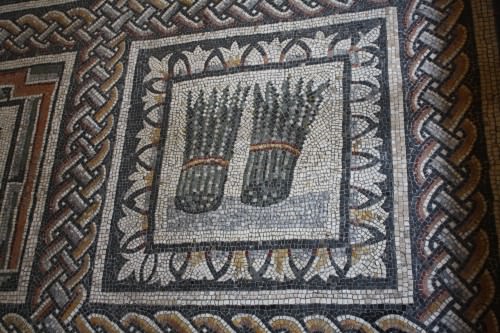
Asparagus, Roman Mosaic
FRUIT & VEGETABLES
The most commonly available fruits were apples, figs and grapes (fresh and as raisins and unfermented juice known as defrutum ) but there were also pears, plums, dates, cherries, and peaches. Several of these could also be dried to increase their shelf-life. Vegetables were typically, but not exclusively, legumes and included beans, lentils, and peas. As an excellent source of protein, they were often mixed into bread. Other vegetables included asparagus, mushrooms, onions, turnip, radishes, cabbage, lettuce, leek, celery, cucumbers, artichokes and garlic. Romans also ate wild plants when available. Olives and olive oil were, of course, as today, a staple food and an important source of fats. Both fruit and vegetables could also be pickled in either brine or vinegar or preserved in wine, grape juice, or honey, again to conserve them for out-of-season consumption.
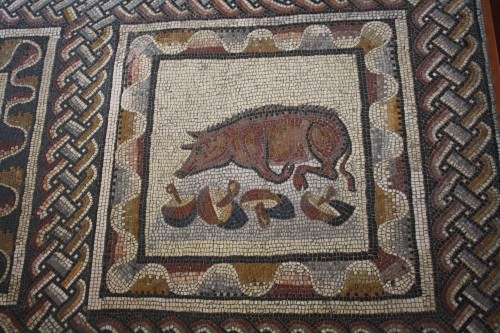
Wild Boar, Roman Mosaic
MEAT
Meat could be an expensive commodity for most Romans and so was commonly prepared as small cuts or sausages. Poultry and wild game were important sources of meat, but pork, veal, mutton, and goat were also available. Game such as rabbit, hare, boar, and deer could also be farmed in large enclosed areas of forest. An astonishing variety of birds such as partridges, pheasants, geese, ducks, blackbirds, doves, magpies, plovers, woodcocks, and quails were also valued for their meat (caught wild or farmed), and just about any sizeable exotic bird, from flamingo to peacock, ostrich to parrot could find itself in the cooking pot of an aristocrat's chef, eager to impress his master's honoured dinner guests. Meat could also be conserved by salting, drying, smoking, curing, pickling, and preservation in honey.
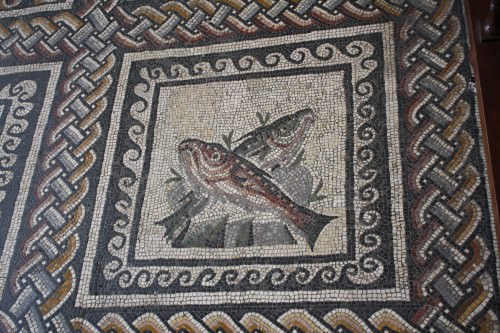
Roman Mosaic
SEAFOOD
Fish, most of which are still found in the Mediterranean today, could be eaten fresh, dried, salted, smoked or pickled. As supply was irregular, the preservation of fish ensured a useful protein addition to the Roman diet. Fish and shellfish were also farmed in artificial salt and fresh-water ponds. Fish sauce ( garum ) made from matured whole small fish or the interior of larger fish was an extremely popular method of flavouring. Crayfish and crabs were also eaten and shellfish available included mussels, clams, scallops, and oysters.
SUPPLY
As the city of Rome grew, the demand for a regular food supply increased. Private enterprises largely met the needs of the citizens and foodstuffs mostly came from the Italian mainland and the larger islands such as Sicily and Sardinia. In the Republic, magistrates did strive to win public favour by securing foodstuffs from subject provinces and allied states. Gracchus took the popular step of establishing a monthly quota ( frumentatio ) of grain set at a reasonable fixed price for citizens.Augustus appointed a praefectus annonae whose job was to specifically oversee the regular supply of foodstuffs, especially grain. Grain was controlled by the state, as it was a form of tax in Italy and Africa. From the 2nd century CE, olive oil was also given out to the people; in the 3rd century pork and wine were given out, too, as part of the frumentatio for poorer citizens. In the later empire, as the state apparatus weakened, richer private individuals and the Church took over some of the responsibilities of maintaining a regular food supply.
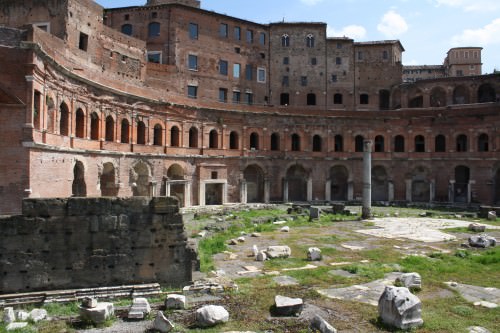
Trajans Market, Rome
Citizens, if they did not grow their own supplies, bought their food at a private market ( macellum ). These were held in the public forums of Roman towns, either in the open air or in dedicated market halls. In Rome the food market was daily from the 2nd century BCE, one of the most famous and biggest locations being Trajan 's Market, a sort of ancient shopping mall. In provincial towns, a weekly market was the norm. Private estates in the countryside could also hold their own markets, directly selling their produce to the surrounding populace.
COOKING
Roman towns had inns ( cauponae ) and taverns ( popinae ) where patrons could buy prepared meals and enjoy a drink of cheap wine ( beer was only consumed in the northern provinces of the empire), but they seldom had a good reputation, thanks to their association with a lack of cleanliness and prostitution, and so they were generally avoided by the more well-to-do citizens. Bakeries could provide the sufficiently hot ovens needed for bread-making, where often customers brought their own bread dough and used only the bakery's oven to bake it. Aside from these establishments, though, cooking was still very much a household activity. Using a brazier, food was roasted, broiled, and boiled. The art of good cooking was particularly associated with mixing condiments well to create tasty and unique sauces using wine, oils, vinegar, herbs, spices, and meat or fish juices. There were even writers who offered helpful cooking advice, such as Apicius who wrote On the Art of Cookery, a collection of 4th century CE recipes.
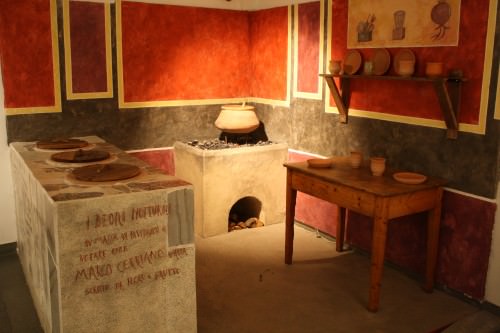
Roman Food Shop Reconstruction
Spices ( species - meaning any valuable exotic commodity), in particular, offered an infinite variety of taste combinations and no fewer than 142 different types have been identified in ancient sources. They often came from Asia, and the possibilities only increased from the 1st century CE when direct sea routes were opened up to Egypt and India. These exotic spices included ginger, cloves, nutmeg, turmeric, cardamom, cassia, mace, cinnamon, and, most popular of all, pepper. Tasty additives produced closer to home included basil, rosemary, sage, chive, bay, dill, fennel, thyme, and mustard.
MEALS
In the early Republic the main meal of the day was at lunchtime and called cena, with a lighter meal being eaten in the evening ( vesperna ). Over time, cena slowly moved later and later in the day until it eventually became the evening meal. The lunchtime meal then became known as prandium. A typical lunch was light, consisting of fish or eggs with vegetables. To start the day, breakfast or ientaculum, was also light, sometimes merely bread and salt but occasionally with fruit and cheese.

Fruit, Roman Mosaic
Saving themselves up for cena, then, the Romans, or at least those who could afford to, made it a big meal, typically with three parts. First came gustatio with eggs, shellfish, dormice, and olives, all washed down with a cup of wine which was diluted with water and sweetened with honey ( mulsum ). Following these starters, cena moved into top gear with a series of courses ( fecula ), sometimes up to seven, and including the star dish, the caput cenae. Meat or fish were the obvious main dish;sometimes even a whole roast pig was prepared. Naturally, richer households would try to wow their guests with exotic dishes such as ostriches and peacocks. The final stage was dessert ( mensae secundae ) which could include nuts, fruit, or even snails and more shellfish.
CONCLUSION
Just who exactly ate what and when in Roman times continues to be a fertile area of scholarship, but the archaeological record provides ample evidence of the variety of foodstuffs available to at least some of the Roman populace. We can also see that the Romans were skilled at ensuring a continuous supply of those foodstuffs through diverse agricultural practices, artificial farming techniques, and food preservation methods. Indeed, their relative success is indicated by the fact that such a scale of food production would not be seen again in Europe until the 18th century CE.
LICENSE:
Article based on information obtained from these sources:with permission from the Website Ancient History Encyclopedia
Content is available under License Creative Commons: Attribution-NonCommercial-ShareAlike 3.0 Unported. CC-BY-NC-SA License